Tottenham Hotspur have moved from one Portuguese manager to another, with Nuno Espirito Santo being appointed as Jose Mourinho’s successor at the Tottenham Hotspur Stadium, via an interim spell for Ryan Mason. Nuno does seem to be a rather belated choice for Daniel Levy, with Spurs having tried and failed to bring in Antonio Conte, Erik ten Hag, Paulo Fonseca and Gennaro Gattuso before finally settling for the former Wolves manager. However, there is reason to be optimistic about this appointment, as Nuno has shown his managerial acumen during a superb spell in charge of Wolves, who became a solid Premier League side following a Championship-winning season where they blew most teams away. He has also previously managed at Porto and Valencia, with mixed results, and in this tactical analysis piece, we will break down Nuno’s philosophy and past managerial record to try and predict what he may do while in charge of Tottenham.
His work at Valencia, Porto and Wolves
Nuno spent four seasons at Wolves, before which he had a solitary season in charge of Porto, and two seasons as Valencia head coach. Before we look at some specific tactical examples and situations, it will be informative to look at his past managerial record to try and understand just what to expect at Tottenham in the upcoming Premier League season.

This table has a few key metrics from Nuno’s last five seasons as a manager (data was not available for the 2014-15 season when he was in charge of Valencia, while he was fired just a couple of months into the 2015-16 season, making comparisons to that season pretty useless). We can see that the final position in the league table was largely dependent on the quality of the squad and team – he took Porto to second place in the Primeira Liga behind Benfica in 2016-17, and won the Championship handsomely with Wolves the next season, but has been largely in and around mid-table in the Premier League since. He also finished 4th with Valencia in the 2014-15 season, but a severe downturn in form led to his sacking in November 2015, just a few months after the start of the next season.
In terms of pressing intensity, Nuno’s teams usually look to sit back and invite the opposition onto them – his solitary season at Porto is the only exception to this, where they had the 2nd-lowest PPDA in the league i.e. they were only behind Benfica in terms of pressing intensity. We can see how his sides have been among the teams with the highest PPDA since then, and this is something that can be expected to take place with Tottenham as well. It is a similar story when it comes to possession as well – barring Porto, his teams have usually averaged under 50% possession, and this points towards Spurs being a team that will look to sit back and counter-attack, rather than one that will take the game to the opposition under Nuno.
As we look at this data, it is becoming increasingly clear that the season at Porto has been the outlier, although this is also the only time when he had a squad capable of challenging for a league title. Wolves have been around mid-table for xG over the last three seasons in the Premier League, but they were much better in the Championship, which again links back to our earlier point – that Nuno has done well when he has had a quality squad at his disposal, and that Wolves side was certainly the best in the Championship during that season. It is also notable that Wolves scored much fewer goals than their xG numbers would suggest in the last three seasons, and this is something that we can expect to see being reversed at Tottenham, especially if Harry Kane sticks around.
However, one area where Nuno will bring immediate improvement is in defence – his sides have been generally quite difficult to break down and score against, as seen by the xGA and goals conceded numbers. Wolves have been among the best teams in the league for both metrics, barring last season, which can be considered an outlier, given the impact of the pandemic along with his decision to move away from the tried-and-trusted back three to a back four midway through the season. Given Spurs’ defensive problems last season, this should be a welcome boost for the squad, and is linked to the likely use of a back three in the upcoming season as well.
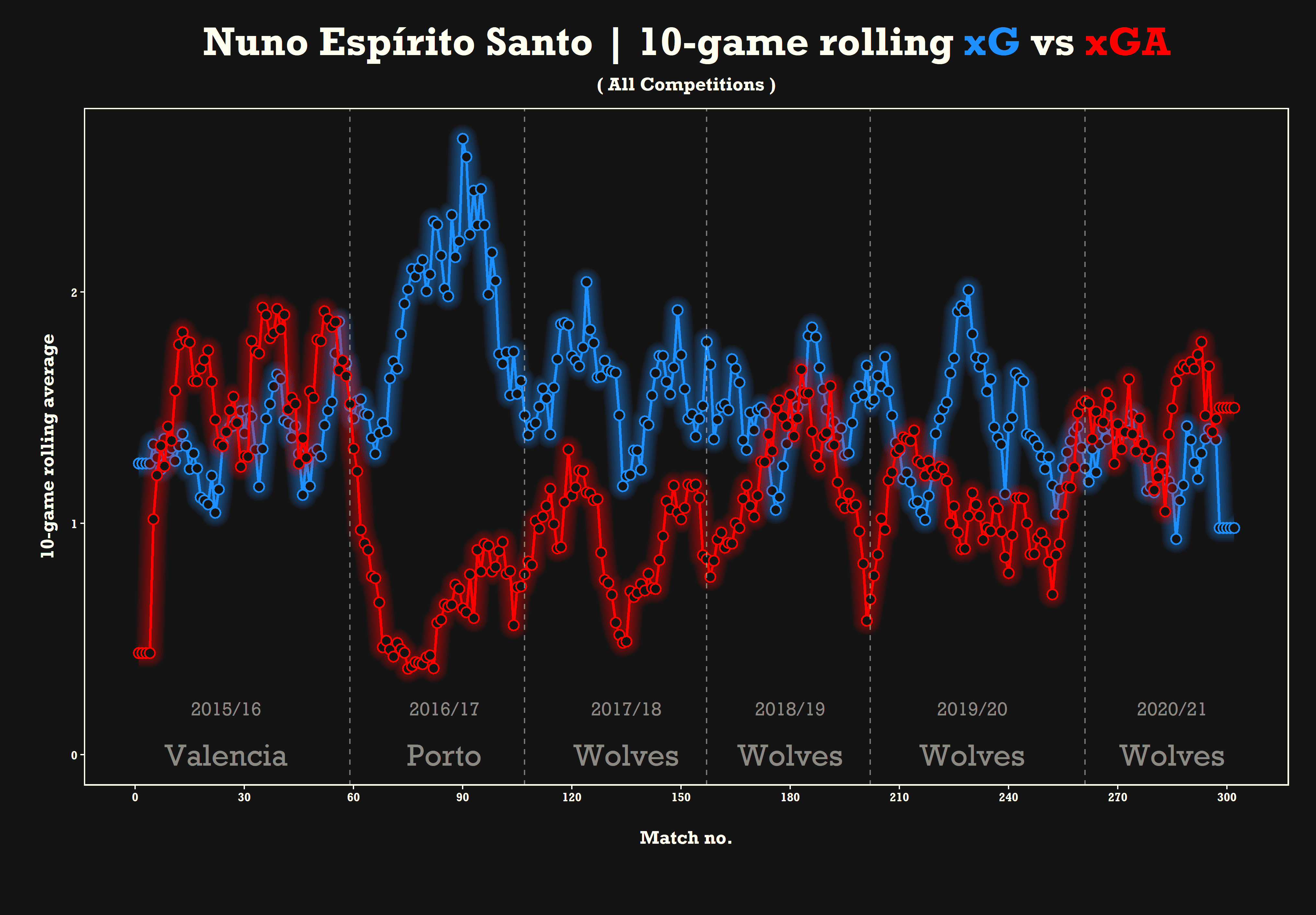
This rolling average for xG and xGA is a good way to see Nuno’s ability to generate improvement for his sides, both in terms of creating and letting up chances. It is immediately obvious that the 2016/17 and 2017/18 seasons were the best of his career in this regard, as the xG far exceeds the xGA totals for these time periods. He did manage to generate periods of good form at Wolves as well, most notably in the 2019/20 season, and we can also see the drop-off that took place last season. Overall, it is clear that his sides are generally quite good at restricting the opposition, with the xGA usually averaging around 1, and it is the attacking side of things that could take some time to click for Tottenham.
Potential formation and setup
Nuno is not wedded to a particular shape or style of play – he is a pragmatist in the true sense of the word, someone who is willing and able to change his team’s style of play depending on the players available to him as well as the opposition, along with other factors and circumstances. He did use a back three almost exclusively at Wolves for four seasons, only changing to a back four last season, with mixed results. In our estimation, the current Spurs squad is actually quite well-suited to playing in a back three, and their rumoured transfer targets, such as the Bologna defender Takehiro Tomiyasu, reinforce the notion that Nuno will look to play with a back three in the upcoming season.
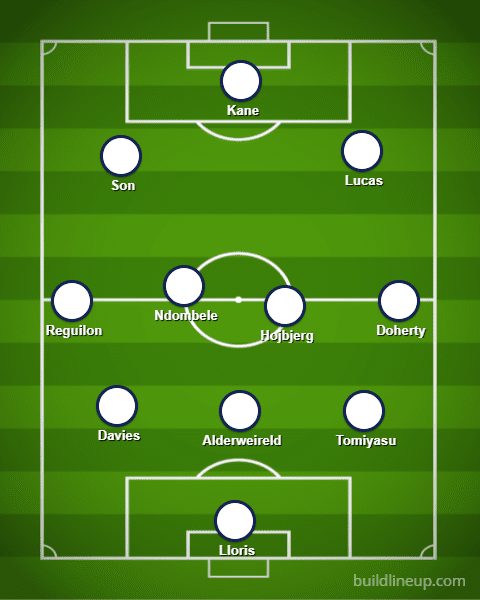
This is one potential lineup that we can expect to see Spurs in next season, assuming that the signing of Tomiyasu goes through. It would immediately put a number of players in positions that would amplify their strengths and minimize weaknesses. Matt Doherty is one of the best examples here – the Irish international came to prominence under Nuno at Wolves, where he thrived at wing-back, and being restored to this position should be much better for him, as he struggled while playing at right-back last season. The back three should all also be quite comfortable in these roles, while both Ben Davies and Tomiyasu can play at full-back too. Pierre-Emile Hojbjerg was a revelation for Denmark at EURO 2020 as part of a double pivot in front of a three-man defence, as it allowed him to get up the pitch and act as a creative influence, rather than the defensive role he carried out for Tottenham last season, and Nuno should look to unlock this side of his playing profile. The front three will have the freedom to stay relatively higher up the pitch, and will be able to play quick combinations between each other, with Kane dropping deep, and Son Heung-min and Lucas Moura playing off him.
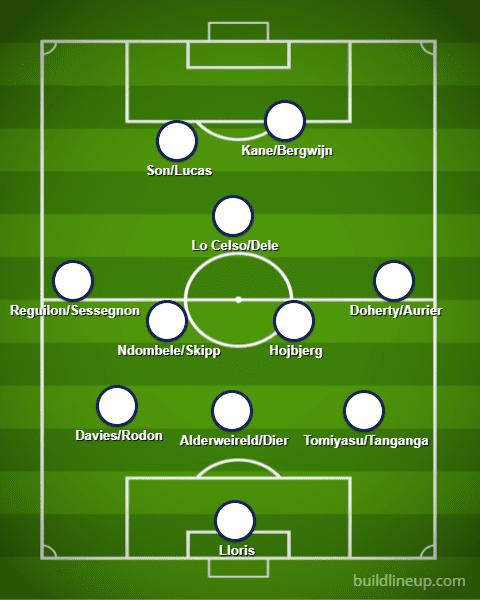
This is another potential lineup that we can see from Nuno, as he played both a 3-4-3 and 3-5-2 fairly regularly at Wolves. I have provided potential alternatives to the first-choice players for each position, and this shape also opens up a spot for an additional midfielder, bringing Dele and Giovani Lo Celso into the equation.
Specific tactical situations
Assuming that Nuno will set Spurs up in one of these two formations, we can now look at some specific tactical situations that are likely to arise next season.
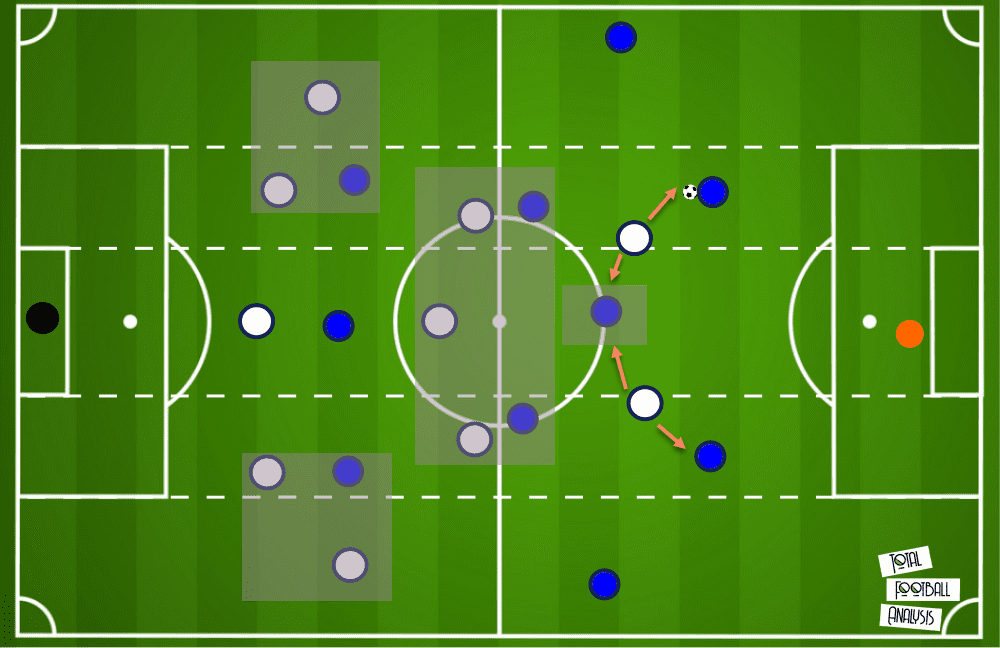
The first example is a look at how Spurs will set up in a 3-5-2 when out of possession. The opposition is in a 4-3-3 shape here, with the wingers staying narrow in the build-up phase. When the ball is with the opposition centre-backs, the two strikers will stay central to block easy passes to the opposition ‘6’, and force the centre-backs to pass to the full-backs, which will then trigger the press. We can also see how Spurs will have numerical advantages in key areas of the pitch through this setup – a 3v2 in midfield, along with a 2v1 out wide, as the wide centre-backs and wing-backs outnumber the opposition winger.
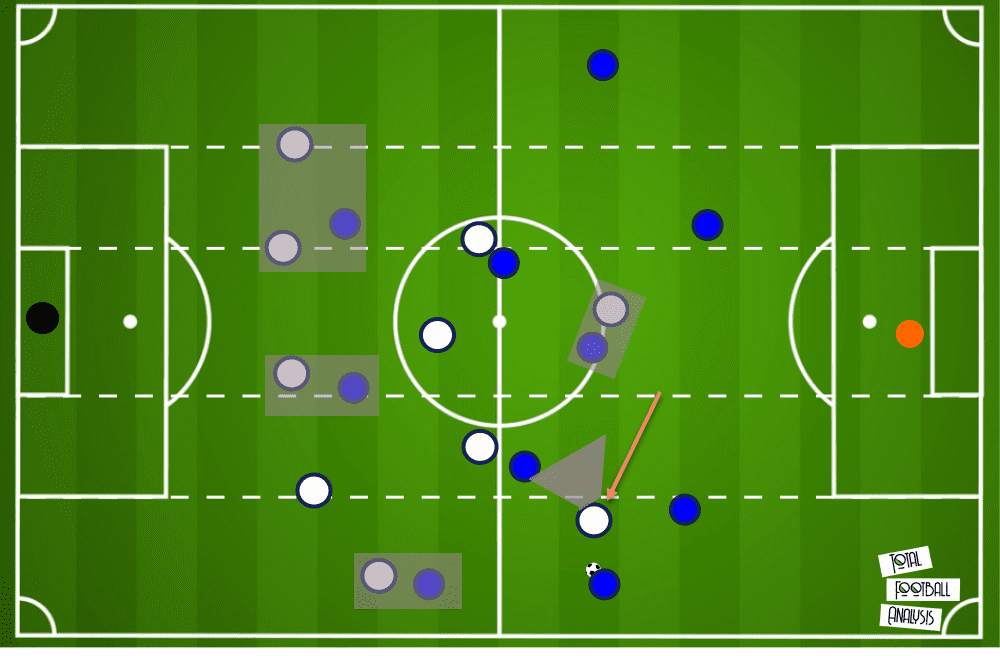
The next image shows this pressing trap in action. As the ball is played out to the left-back in this example, the ball-near striker will move across, using his cover shadow to block a pass infield to the central midfielder. The ball-far striker will stick tight to the midfield pivot, while also staying close enough to press the centre-back if needed. The wing-back on that side will also move higher to track the winger, who will drop deep to offer a passing option down the line, with the other defenders still managing to create a numerical overload against the remaining attackers.
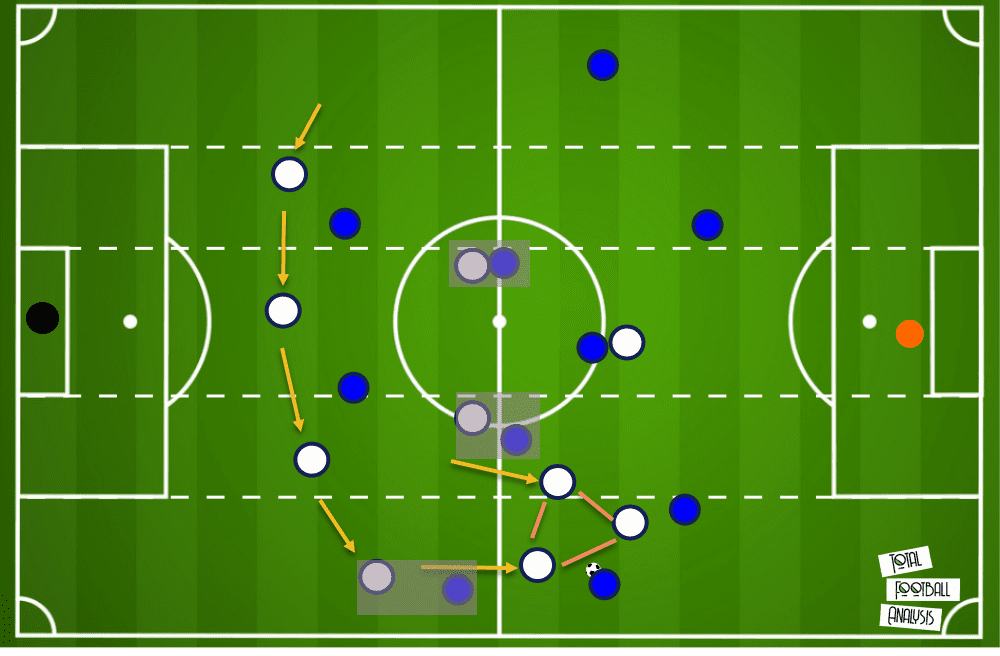
This is how Tottenham can then win the ball back in this situation. The wing-back will advance, aggressively pressing the left-back, with one of the central midfielders moving up as well to support, and forming a wide triangle of sorts to block the left-back’s passing options. The remaining central midfielders will stay tight to their direct opponents, while the defenders will move across to form a back four and cover for the advancing wing-back.
One of the situations when a 3-5-2 is used is when the opposition is good at playing through central areas, and so the aim is to deny central progression and force them wide, where the ball can be won back. These examples show just how this system would work under Nuno – it is something that his Wolves side were excellent at, and will definitely be replicated at the Tottenham Hotspur Stadium next season.
However, we have already mentioned how Wolves moved between a 3-5-2 and a 3-4-3 quite regularly, and it is likely that this sort of flexibility will be seen at Spurs as well.
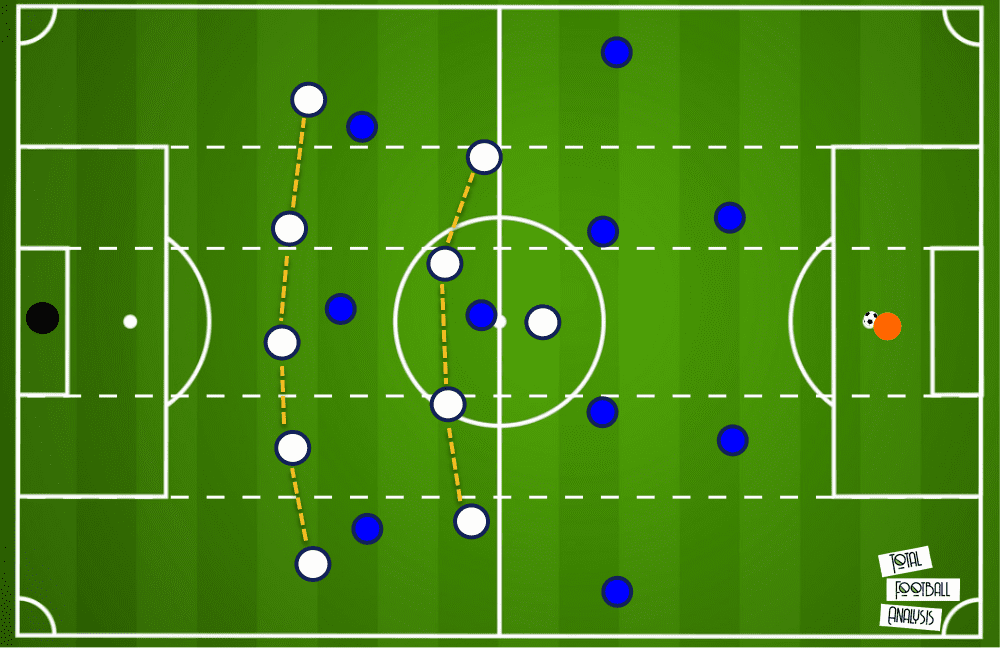
While the 3-5-2 is used against opponents who are good at central progression, the 3-4-3 is deployed when opponents prefer to use the flanks to advance upfield. With wing-backs and wingers, your team can ensure that they are not overloaded in the wide spaces, while the defensive shape can be set up in a way to cover the width of the pitch. This is exactly how Spurs will play out of possession under Nuno in this shape – the wingers and wing-backs will drop back to form a 5-4-1 that covers the wide areas, with the midfield line shifting across horizontally when needed, and making it easier to defend against wingers as well as advancing full-backs, while the lone striker will also drop off and shadow the opposition’s creative midfielder.
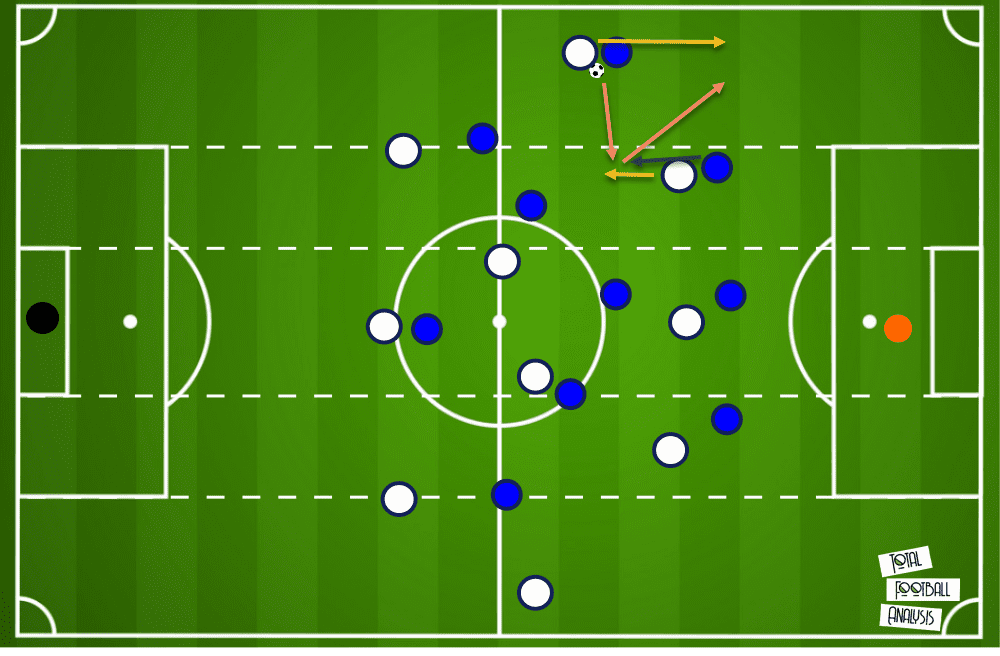
While we cannot be certain of how Spurs will play in possession, there are some patterns of play that Wolves used quite frequently under Nuno, and it can therefore be assumed that we will see these at Tottenham as well. In the 3-4-3, it is vital to use the wide spaces when attacking, and one of the most common ways in which Wolves attacked can be seen in the above image. Both wingers would stay narrow and close to the striker to draw the opposition defensive line narrow as well, and create space for the wing-backs to move forward. The winger on the ball side would drop off to offer a simple wall pass, drawing the defender out with him, and therefore creating the space for a one-two, with the wing-back then able to burst past his man and attack the space behind the defensive line, as the other attackers rush into the box to get on the end of crosses or cut-backs. This can work quite well in the Spurs set-up – just imagine Sergio Reguilon and Doherty as the wing-backs, with Son, Lucas or Steven Bergwijn as the wide forwards, and you can see how Spurs could work this sort of situation to their advantage next season.
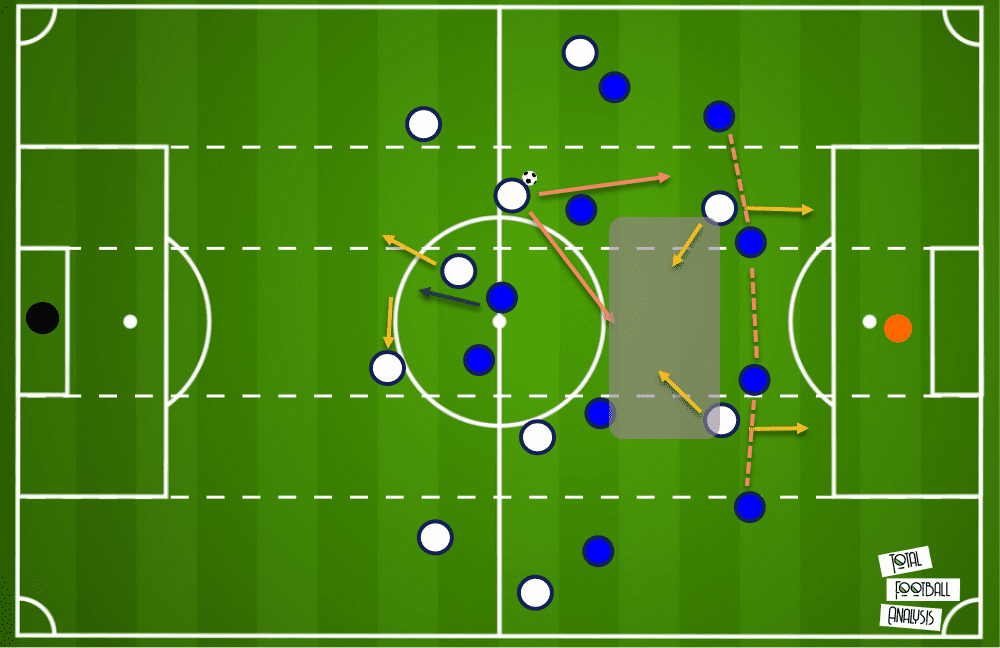
On the other hand, in the 3-5-2, it is the central space that will be attacked, and this is another commonly seen pattern that Spurs will potentially use next season. One of the three midfielders will drop deep into the defensive line, drawing out an opposition midfielder. At the same time, the two strikers will stay high to pin the defensive line, creating space between the lines for one of the other central midfielders to advance into, as shown above. One of the two strikers can also drop off to combine with this player, and this sort of setup will be especially beneficial for Tanguy Ndombele. The Frenchman is excellent at carrying the ball upfield, and he is likely to be fielded on the left of a midfield trio for Tottenham, giving him the space to run forward and influence the game from higher up the pitch in this manner.
Conclusion
In Nuno Espirito Santo, Spurs have hired an excellent manager – one who is capable of adapting to changes and setbacks, while he will also create a good atmosphere in the dressing room and on the training ground. This extremely important as well, given the toxicity that had marked the end of Jose Mourinho’s tenure, and Nuno’s empathy and compassion should make him popular with the Spurs squad in no time. In terms of his work on the pitch and the expected tactics, we can expect to see Spurs’ defence improve markedly, and while their attack could take a little more time to gel, keeping hold of Harry Kane will speed that process up significantly.





Comments